Intel Beast Canyon NUC Review: Desktop Tiger Lake Debuts in SFF Gaming Powerhouse
by Ganesh T S on July 29, 2021 9:00 AM EST- Posted in
- Systems
- Intel
- NUC
- Tiger Lake
- NUC11
- Beast Canyon
BAPCo SYSmark 25
The Intel NUC11BTMi9 (Beast Canyon) was evaluated using our Fall 2018 test suite for small-form factor PCs. In the first section, we will be looking at SYSmark 25.
BAPCo's SYSmark 25 is an application-based benchmark that uses real-world applications to replay usage patterns of business users in the areas of productivity, creativity, and responsiveness. The 'Productivity Scenario' covers office-centric activities including word processing, spreadsheet usage, financial analysis, software development, application installation, file compression, and e-mail management. The 'Creativity Scenario' represents media-centric activities such as digital photo processing, AI and ML for face recognition in photos and videos for the purpose of content creation, etc. The 'Responsiveness Scenario' evaluates the ability of the system to react in a quick manner to user inputs in areas such as application and file launches, web browsing, and multi-tasking.
Scores are meant to be compared against a reference desktop (the SYSmark 25 calibration system, a Lenovo Thinkcenter M720q with a Core i5-8500T and 8GB of DDR4 memory to go with a 256GB M.2 NVMe SSD). The calibration system scores 1000 in each of the scenarios. A score of, say, 2000, would imply that the system under test is twice as fast as the reference system.
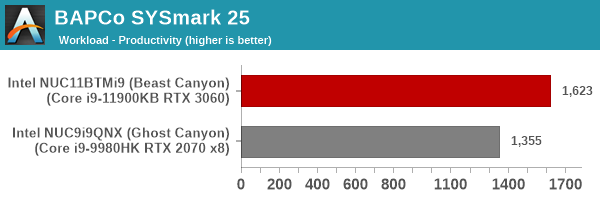
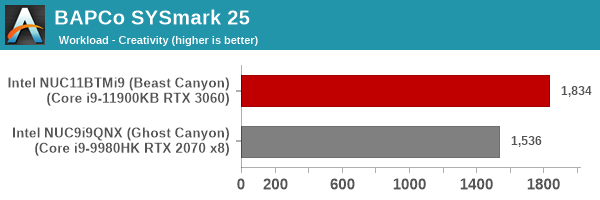
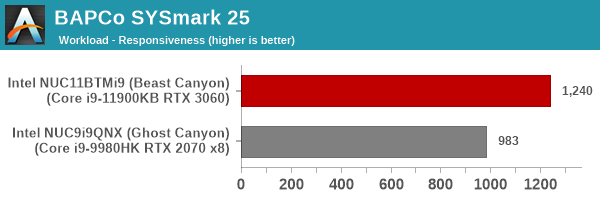
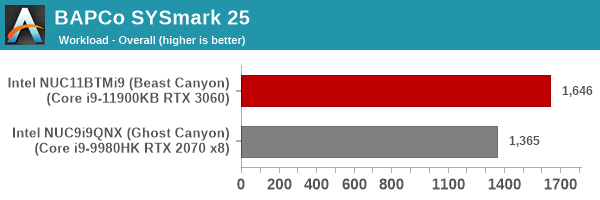
SYSmark 25 also adds energy measurement to the mix. A high score in the SYSmark benchmarks might be nice to have, but, potential customers also need to determine the balance between power consumption and the efficiency of the system. For example, in the average office scenario, it might not be worth purchasing a noisy and power-hungry PC just because it ends up with a 2000 score in the SYSmark 2014 SE benchmarks. In order to provide a balanced perspective, SYSmark 25 also allows vendors and decision makers to track the energy consumption during each workload. In the graphs below, we find the total energy consumed by the PC under test for a single iteration of each SYSmark 25 workload. For reference, the calibration system consumes 8.88 Wh for productivity, 10.81 Wh for creativity, and 19.69 Wh overall.
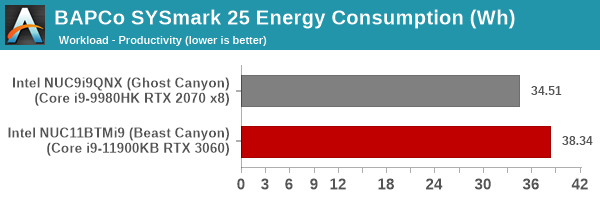
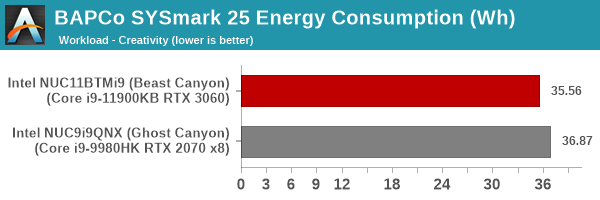
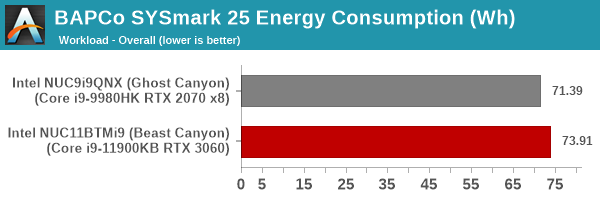
The Beast Canyon outscores the Ghost Canyon by around 20%. The increase in energy consumption is miniscule.










84 Comments
View All Comments
Spunjji - Friday, July 30, 2021 - link
The original "Next Unit of Computing" was specifically meant to be an extremely small (below ITX sized) system that was significantly smaller than could be assembled by an end-user from off-the-shelf parts - not just an "SFF desktop".Kaby G was a stretch, but it was still as small as you could get for the power. As notashill noted this one is way, way past that goal. They're free to dilute their branding if they want to, but that's absolutely what they're doing here.
Tams80 - Sunday, August 8, 2021 - link
Eh. Is it really offering anything unique that is hard (too hard) for an average person to bodge together on their own from off the shelf parts?No, it isn't. The other NUCs so far have been something you couldn't just buy the components for and assemble with no skill in perhaps an hour.
mode_13h - Monday, August 9, 2021 - link
> Is it really offering anything unique that is hard (too hard) for> an average person to bodge together on their own from off the shelf parts?
Please show me where I can find a Tiger Lake-H CPU and motherboard, off-the-shelf. You can't because it's BGA-only.
> The other NUCs so far have been something you couldn't just buy the components
> for and assemble with no skill in perhaps an hour.
Because (like this!) they use laptop parts in a (compact) desktop enclosure.
In this case, the only real exception is the GPU. And the fact that it's on a regular graphics card is a feature, since that makes it upgradable.
defaultluser - Thursday, July 29, 2021 - link
Yeah, they even phoned-in the case design - it's exactly the same look as a Cougar QBX.https://www.newegg.com/p/N82E16811553020?quicklink...
powerarmour - Thursday, July 29, 2021 - link
Exactly, I'm struggling to see any genuine innovation here, at least it was fun seeing what they could cram into 1.2L, now they might as well rebrand Alienware boxes and call it a day.Apple will have M2 ready soon, and here we have another generic 5L bread bin with a 650W PSU.
Spunjji - Friday, July 30, 2021 - link
Oh neat - a new case to look at next time I do an SFF build. Thanks!beginner99 - Thursday, July 29, 2021 - link
Fully agree. You can get smaller sff pc cases than this and put similar components in it. The NUC has been about not being able to build such a small thing yourself because it was essentially custom.damianrobertjones - Friday, July 30, 2021 - link
'Next Unit of Computing'.Nowhere does it state that they have to be small.
powerarmour - Friday, July 30, 2021 - link
And toilets don't have to be bowl shaped either... there's a clear inference (after eight generations at least) that these things should be small and compact.Wrs - Saturday, July 31, 2021 - link
It does remove a lot of the purpose for buying it when any old SFF case can house the same components without locking you to Intel cards